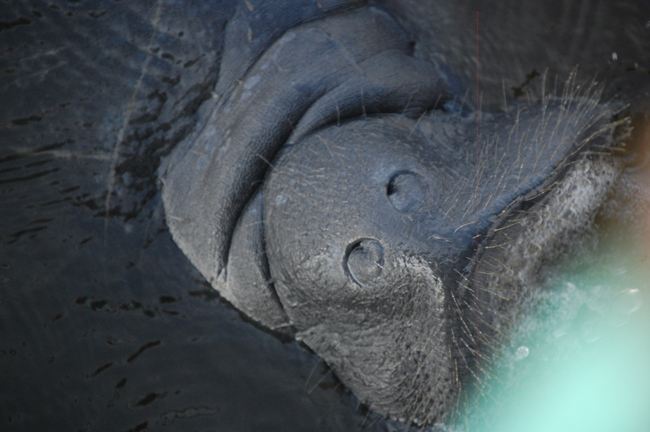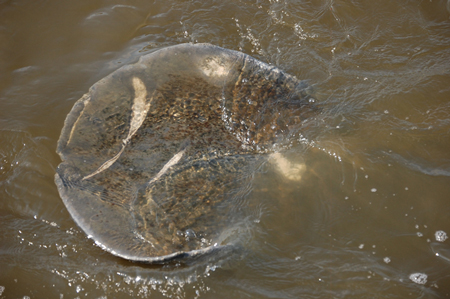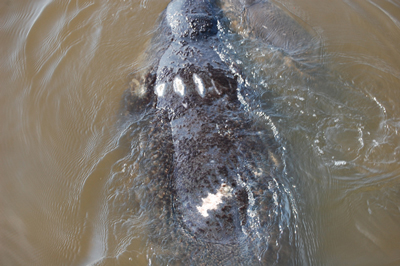
Other than the one time I saw one in a controlled tank at Epcot, I’d never seen manatees in their own environment, up close. That changed yesterday.
I was on a dock on the Intracoastal at around 5 p.m., across the inlet to Mirror Lake. And there they were. Three, four, five, maybe six of them, including a baby nuzzling up to its mother. They were snorting, rolling, ambling around and below the dock like primitive but oddly flexible submarines. They’d disappear. The water would look its muddy indifferent self. Then swirls would form, the sign of hugeness lurking beneath, and one of them would surface, snort, twirl, and go back under in that natural slow motion that could stop Big Ben from ticking. They look almost as big as Big Ben, too, these animals that weigh 1,000 pounds or more and live long enough to qualify for Social Security.
Click On:
- How a Boating Guru Turned Manatee Advocate
- 10 Named to Flagler’s Manatee Rules Panel
- Florida Manatee Deaths/Mortality 2009
- List of Florida Threatened and Endangered Species
They sort of do. They’re listed as one of Florida’s 40 endangered animals, though there’s some debate over whether they should be. The 2005-2006 Fish and Wildlife Conservation Commission‘s Florida Manatee Biological Review Panel recommended that the Florida manatee be listed as Threatened–still not all that reassuring, if you’re a manatee (or a lover of manatees). But what that would mean is that the likelihood of your extinction, as a manatee, would be considered low, at least over the next few decades.
The numbers don’t suggest anything like fruitfulness. An authoritative manatee census put their number in all of Florida at 2,310 adult animals a few years ago. That’s not a lot of manatees no matter how big they are. And last year was particularly deadly: 429 recorded manatee deaths in Florida, 97 by watercraft, just 37 from natural causes.

Evidence of the argument’s stupidity was in front of my eyes. I took a lot of pictures. At least two manatees showed the sort of damage, on their back and on their tail, that looked alarmingly like the slashes of propeller blades.
I wasn’t going to rely on my instant, useless analysis. This morning I shipped the pictures you see here to the Fish and Wildlife Commission, where Karen Parker passed them on to a biologist who works in the agency’s imperiled species section in Tallahassee.

The marks on the tail in the picture further up: “Looks like resolving prop injuries, cold stress lesions, or a combination of both.” I can hear objections now: those are just guesses. The manatees are alive and twirling. There’s risk everywhere. All true. But there’s a difference, talking about these animals in the abstract, and seeing them, and their injuries, up close. They’re not impressions on a license plate anymore. They’re not ideological marking grounds in a public meeting drier than freon. They’re living, audibly breathing remnants of an age predating everything about us. They couldn’t harm an amoeba. But we’re harming them.
In Flagler County, not much: Of the six manatee deaths recorded last year, just one is directly attributable to a watercraft. Same story the previous year. The numbers are higher in Volusia, where there’s more boats, and more congregating manatees. But Flagler’s waterfronts are slowly beginning to sprawl with docks, and if they’re not, the Intracoastal continues to transform into I-95’s hydro echo, with Flagler’s portion as a speedster’s paradise.
Fish and Wildlife is proposing a rule that may bring speed limits to the Intracoastal. Local boaters and “users” of the Intracoastal, as they’re called, are mobilizing against the idea. They’ve stacked a local rules committee, required by law (the committee is, the stacking isn’t) to advise Fish and Wildlife, hoping to make it seem as if Flagler is enthusiastically opposed to any such rules, as if this were the sort of thing that should be decided by a popularity contest. The biggest counterweight to manatee advocates on the committee is none other than Jon Netts, the Palm Coast mayor, who somehow managed to get himself appointed to the rules committee and now chairs it: talk about literally throwing your weight around. So the rules committee is a bit of a sham. But its reach is merely advisory. And it still has its uses as a window into the brackish brawn of local politics and boating interests.
Those propeller marks on manatees are its signature.




























ART WOOSLEY says
Dear Mr.Tristam, A wonderful article, we need many more like it.
Let me say, I am very familiar with this location, as you know I live there. For well over two years now both myself and as many as one hundred other residents,have attempted to keep it safe for these creatures, by resisting the many bureaucratic agencies who would bring harm upon it, all of this to no avail.
**( THE PARTICULAR SITE IS SHOWN ON OFFICIAL FWC MAPS, AS HAVING THE LARGEST CONCENTRATION OF MANATEE’S USING IT ,EVEN MORE SO THAN ANY OTHER IN FLAGLER COUNTY, INCLUDING GAMBLE ROGERS STATE PARK TO THE SOUTH . )
It is sad to say however, the very site you mention is currently being considered for, or has already been issued, by our very own DEP, USACE, FWC, FLAGLER COUNTY ETC. an OPEN ENDED “DREDGING PERMIT”, which means the area may be disturbed by dredging possibly on an annual basis, simply in order to give adequate water depth for a single large vessel.
Keep in mind that dredging in an AQUATIC PRESERVE such as this, is somethig which the DEP states in its own rules they are STRONGLY opposed to ??
Let me say also, that for several days recently many manatees played around this site, and it was obvious that whole families were present. I would estimate that somewhere around fifteen, or more were on site, a number which can certainly be verified by a local prominent photographer, who took many pictures of them.
How very sad, that the very people who are charged with protecting these special creatures from harm, have failed to do so here in OUR very own “Tomoka Marsh Aquatic Preserve”,
I fail to see how they can even look at themselves in a mirror each day for what they did here,each agency was clearly advised of this very special and sensitive location, including the DEP director in Tallahasee Mr.Michael W.Sole.
Even more alarming than this, was the fact that our own Flagler County Officials let us ALL down, they clearly failed to stand their ground, or stand up strongly enough to the abusive state agencies involved.
In other words those state agencies mentioned, were in gross error, and our county officials allowed them to pass their error on to us, an error which this preserve will have to live with long after most of us are gone.
As a result of that weakness, or lack of true concern, our manatee’s safety, and the environment of OUR preserve has been compromised indefinitely. Thank you
John Liccardo says
How can we get the message across so that people will understand that, as our animals go, so will our human population go. As we imperil and threaten our animals especially these defenseless manatees, we imperil and threaten ourselves. A word to the wise should be suffiicient but it rarely is. Your precious words Mr. Tristam, I am afraid, are already fading into oblivion.
Mankind will not respond or react until threatened and in imminent danger, and then quite often it is too late. John L.
elaygee says
Why do boats still have props? There are cheap and easy water propulsion (jets of water pushing the boat) systems. It would save lots of human lives too. Props are so old timey, like buggy whips. They make no sense anymore.
Allan Ferver says
Pierre, You are wasting your time in Flagler County. I have been away for several years now, and
just recently gotten over a malaise , induced by working to help save a once unique ecosystem
for 15 years with no success whatsoever. Manatees will soon be in manmade aquatic display areas. Florida ecosystems have [ had] the ability to sustain a human population of about 6-8 million. The
present population is 18 million plus. Comprehensive plans currently “permit” a population of 80
million. Good luck–as that is only what will help……………….Allan “Mike” Ferver